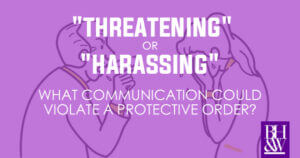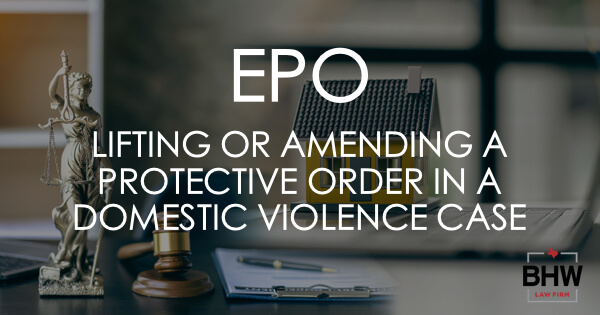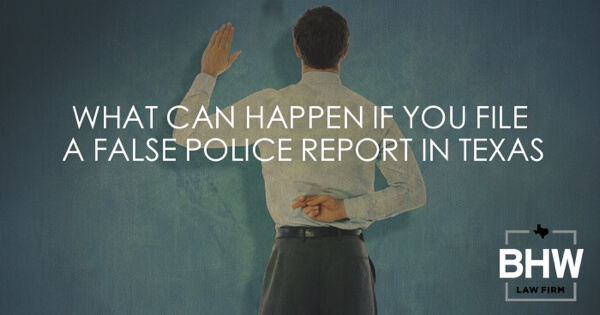 Family violence stories permeate the news, as domestic violence-related cases continue to fill both Texas criminal and family court dockets alike. The Texas Council On Family Violence reports that one in three Texans will experience domestic violence in their lifetimes. (Texas Council On Family Violence, accessed 23 April 2018.) In 2016, the National Domestic Violence Hotline received over 17,000 outcries for help. A societal scourge that is found across all racial, socio-economic, financial, educational and religious stratifications, domestic violence continues to wreck families and ruin the lives of victims. What protections exist in Texas for victims? What behaviors rise to the level to trigger a protective order issued by the courts? What happens when a protective order is violated? In Wagner v. State, the Texas Court of Criminal Appeals recently considered whether numerous texts and emails can rise to the level of harassing behavior and violate a protective order.
Family violence stories permeate the news, as domestic violence-related cases continue to fill both Texas criminal and family court dockets alike. The Texas Council On Family Violence reports that one in three Texans will experience domestic violence in their lifetimes. (Texas Council On Family Violence, accessed 23 April 2018.) In 2016, the National Domestic Violence Hotline received over 17,000 outcries for help. A societal scourge that is found across all racial, socio-economic, financial, educational and religious stratifications, domestic violence continues to wreck families and ruin the lives of victims. What protections exist in Texas for victims? What behaviors rise to the level to trigger a protective order issued by the courts? What happens when a protective order is violated? In Wagner v. State, the Texas Court of Criminal Appeals recently considered whether numerous texts and emails can rise to the level of harassing behavior and violate a protective order.
Read the case here: Wagner v State (Tex. Crim. App 2018)
Domestic Violence Leads to a Protective Order for Victim
One month after separating from her abusive husband, LW was granted an Order of Protection from a district court. Based on the testimony presented, the district court found that not only had family violence occurred, it was likely to occur again in the foreseeable future. In her affidavit to the court, LW described an array of abusive behaviors including yelling and screaming, breaking objects around the house, destroying a car with a hammer, locking LW out of her own house, among other “strange and violent behavior.”
The Protective Order restricted her ex-spouse, Paul-Henri Wagner, from a laundry-list of communications and activities ranging from direct communication by phone to physical presence within 500 feet of LW’s residence. Specifically, Paul-Henri was prohibited from communication made to LW in a “threatening or harassing manner.” One week after the protective order was issued, Paul-Henri and LW sent text messages and email to each other, regarding financial and logistical obligations to their children. Eventually, LW told Paul-Henri to communicate via email only, asking him to “respect her wishes” by not sending her text messages. Shortly thereafter, Paul-Henri began sending emails professing his longing for reconciliation. LW told him to stop. Paul-Henri started sending text messages again—a dozen in fact. Soon the communication became a mix of texts and emails professing his undying love for LW. After a few days of the messages, LW told Paul-Henri to stop sending texts. Paul-Henri barraged LW with emails begging for reconciliation. Paul-Henri even went so far as to drag church members to contact LW for reconciliation.
Based on his incessant communications with LW, Paul-Henri was charged with a Class A misdemeanor Violation of a Protective Order for violating Texas Penal Code Section 25.07(a)(2), which provides (in relevant part:
(a) A person commits an offense if, in violation of a condition of bond set in a family violence case related to the safety of the victim, the person knowingly or intentionally:
(2) communicates:
(A) directly with a protected individual or a member of the family or household in a threatening or harassing manner;
Ultimately, a jury convicted Paul-Henri for violating the protective order, finding that he communicated with LW “in a harassing manner.”
Wagner Appeals the Violation of Protective Order Conviction | Void for Vagueness Argument
On direct appeal, Paul-Henri challenged the constitutionality of the Texas Penal Code, stating that §25.07(a)(2)(A) is overbroad and vague. The court of appeals rejected Paul-Henri’s argument, stating:
(1) that the term “harass” can be defined using a standard dictionary,
(2) that harassment is not protected speech under the First Amendment, and
(3) that the statute is not vague because Paul-Henri either knew or should have known that his repeated communications with LW would eventually pester her.
Paul-Henri then appealed to the Texas Court of Criminal Appeals, which granted his petition for discretionary review to determine the constitutionality of §25.07(a)(2)(A).
When do Communications Become “Harassing” Under the Law? | The Court of Criminal Appeals Weighs In
So when do multiple emails and texts become “harassment” in violation of a protective order language or the Penal Code (or do we even know)? The CCA held that the Penal Code was not unconstitutionally vague on this point and explained that:
“a person communicates in a harassing manner if the…method by which he communicates…would persistently disturb, bother continually, or pester another person…[Such behavior] necessarily requires multiple events of harassing communication…[and would be] troubling [to] someone with frequent…requests or interruptions.”
Here, Paul-Henri repeatedly contacted LW, even after she demanded that he stop. The court reasoned that the average person, with average intelligence, would conclude that his behavior was bothersome, and that he should have stopped. However, Paul-Henri did not stop his efforts to contact his victim. Furthermore, added the CCA, “the First Amendment does not prohibit a court from imposing reasonable restrictions on an abuser’s speech for the protection of his victim.” For those who have protective orders restricting communication, yes, multiple texts and emails may rise to the level of “harassing” behavior in Texas. Those who have been served protective orders need to understand the restrictions placed upon them in their orders and abide accordingly.
Family and intimate partner violence follows escalating patterns of behavior that are predictable and preventable. Understanding the facts about domestic violence is the first step in supporting victims in their safety planning and in holding abusers accountable for their actions.










